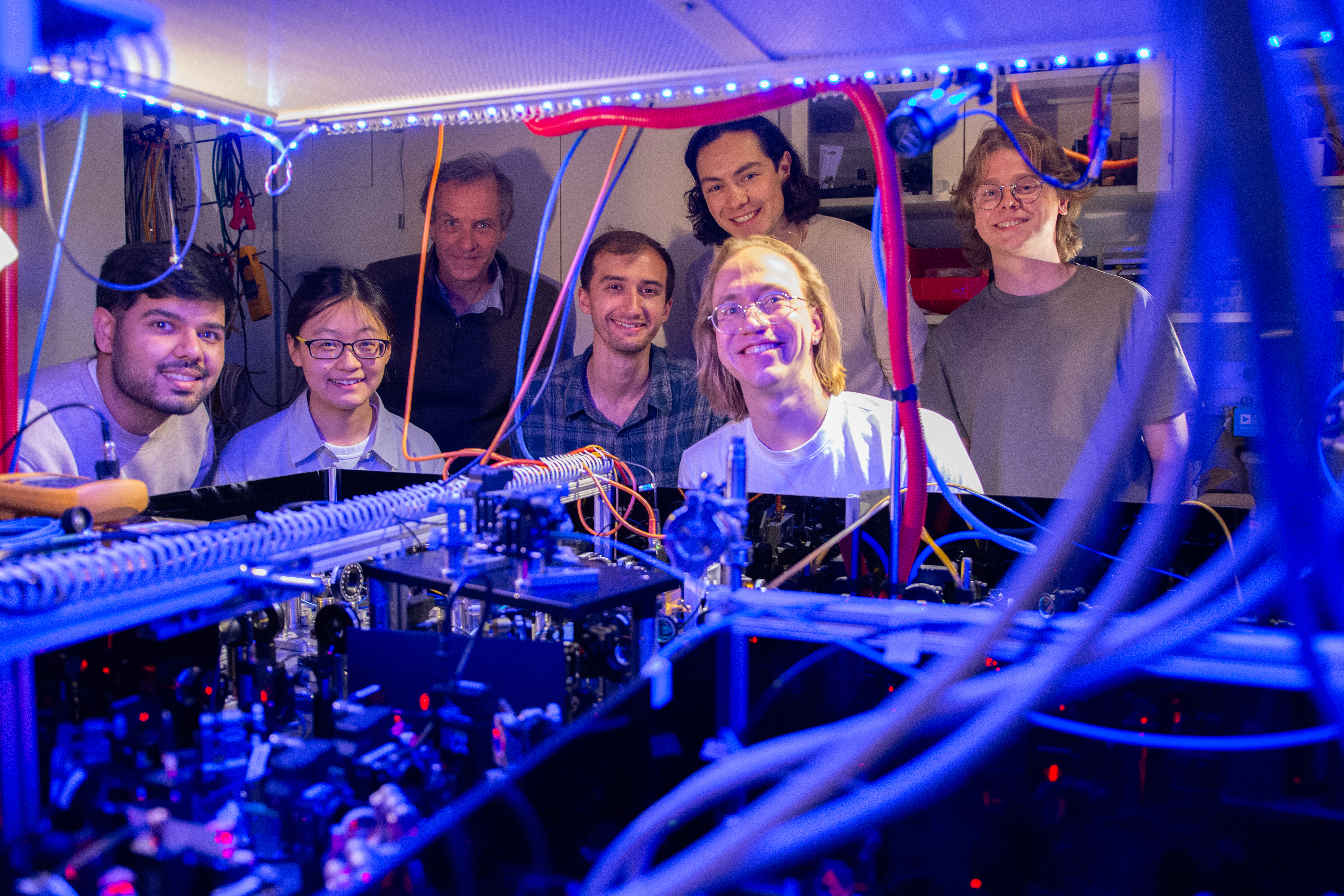Lithium Lab
Postdocs
Graduate Students
Undergraduates
Former Group Members
Undergraduate (2023-2024)
Postdoc (2019-2025)
Graduate Student (2017-2024)
Graduate Student (2015-2020)
Diploma/Master’s Student
Graduate Student (2013-2019)
Postdoc (2015-2018)
Graduate Student (2012-2017)
Graduate Student (2011-2016)
Postdoc (2012-2015)
Graduate Student (2010-2014)
Graduate Student (2007-2012)
Graduate Student (2008-2012)
Diploma/Master’s Student
Hubbard models can help us understand and design quantum materials – materials whose exceptional properties rely on the quantum mechanics of strongly interacting electrons. One prominent example of such materials are high temperature superconductors, which can conduct electricity without any losses and whose application may revolutionize power transmission, energy generation and storage, and medical imaging. Presently we find quantum materials by trial-and-error, and our understanding of how quantum materials work is limited. To better understand such materials, theoretical physicists crafted the Hubbard model, an idealized and simplified model that is believed to capture the rich quantum physics of such materials. It turns out, however, that this simplicity is highly deceiving. Even after sixty years of intensive study, understanding the properties of the Hubbard model remains extremely challenging even with today’s most advanced supercomputers.
The Hubbard model is a quantum model. What makes it so difficult to compute this quantum model on a classical supercomputer is exactly the complexity of quantum mechanics that is believed to make quantum computers much more powerful than classical computers. It is exactly this quantumness from which the surprising and useful material properties emerge.
The idea of our line of research is to build a quantum machine that can quantum mechanically instead of classically simulate the physics of the Hubbard model. We build specialized quantum devices, so called “quantum simulators”, that are purpose-built to exactly realize a wide range of Hubbard models. In recent work we achieved a major breakthrough, where we lowered the temperatures by about a factor of five. This, for the first time, brings quantum simulations into an entirely new regime: In this regime, classical supercomputers have an extremely difficult time providing answers. But it is also a regime where finding answers will have a profound impact on the understanding of quantum materials such as high temperature superconductors.
Now that we reach a low temperature regime that had been inaccessible for decades, we are excited to investigate the low temperature phases that emerge in the two-dimensional Hubbard model. Famously, d-wave superconducting and stripe phases are expected to emerge, and we are starting to explore the “pseudogap” regime that holds significant open questions. With our new, programmable optical lattice, we will be able to explore a wide range of geometries beyond the “plain vanilla” Hubbard model, and map out uncharted landscapes in which entirely new quantum phases may emerge.
Pseudogap in a Fermi-Hubbard quantum simulator
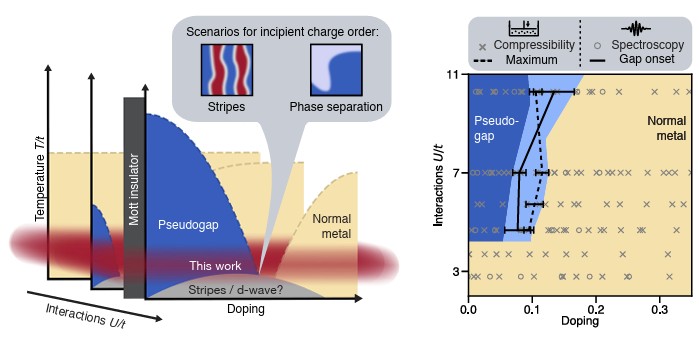 Understanding doped Mott insulators is a fundamental goal in condensed matter physics, with relevance to cuprate superconductors and other quantum materials. The doped Hubbard model minimally describes such systems, and has explicated some of their complex behavior. However, many open questions remain concerning the anomalous metallic states which emerge at low temperatures and intermediate doping and which, in cuprates, give rise to high-temperature superconductivity upon cooling. Here we observe a crossover between a normal metal and a pseudogapped metal in the Hubbard model by performing thermodynamic and spectroscopic measurements in a cold atom quantum simulator, leveraging a recent several-fold reduction in experimentally achievable temperatures. Measurements of the compressibility show a maximum versus doping that develops upon cooling, signaling an inflection point in the equation of state. We track this maximum versus interaction strength, revealing a line of thermodynamic anomalies in the phase diagram that separates an underdoped from an overdoped metal at large interactions. Lattice modulation spectroscopy shows a loss of spectral weight at low energies in the underdoped regime which is non-uniform in the Brillouin zone, indicating the formation of a pseudogap. We use this signal to establish a pseudogap phase diagram as a function of interactions and doping. Our results experimentally demonstrate the existence of a pseudogapped metal in the Hubbard model, partially characterize the pseudogap regime, and suggest a link between the pseudogap and charge order which can be probed in future work. Furthermore, this work demonstrates the utility of quantum simulation in addressing frontier problems in correlated electron physics.
Understanding doped Mott insulators is a fundamental goal in condensed matter physics, with relevance to cuprate superconductors and other quantum materials. The doped Hubbard model minimally describes such systems, and has explicated some of their complex behavior. However, many open questions remain concerning the anomalous metallic states which emerge at low temperatures and intermediate doping and which, in cuprates, give rise to high-temperature superconductivity upon cooling. Here we observe a crossover between a normal metal and a pseudogapped metal in the Hubbard model by performing thermodynamic and spectroscopic measurements in a cold atom quantum simulator, leveraging a recent several-fold reduction in experimentally achievable temperatures. Measurements of the compressibility show a maximum versus doping that develops upon cooling, signaling an inflection point in the equation of state. We track this maximum versus interaction strength, revealing a line of thermodynamic anomalies in the phase diagram that separates an underdoped from an overdoped metal at large interactions. Lattice modulation spectroscopy shows a loss of spectral weight at low energies in the underdoped regime which is non-uniform in the Brillouin zone, indicating the formation of a pseudogap. We use this signal to establish a pseudogap phase diagram as a function of interactions and doping. Our results experimentally demonstrate the existence of a pseudogapped metal in the Hubbard model, partially characterize the pseudogap regime, and suggest a link between the pseudogap and charge order which can be probed in future work. Furthermore, this work demonstrates the utility of quantum simulation in addressing frontier problems in correlated electron physics.
A neutral-atom Hubbard quantum simulator in the cryogenic regime
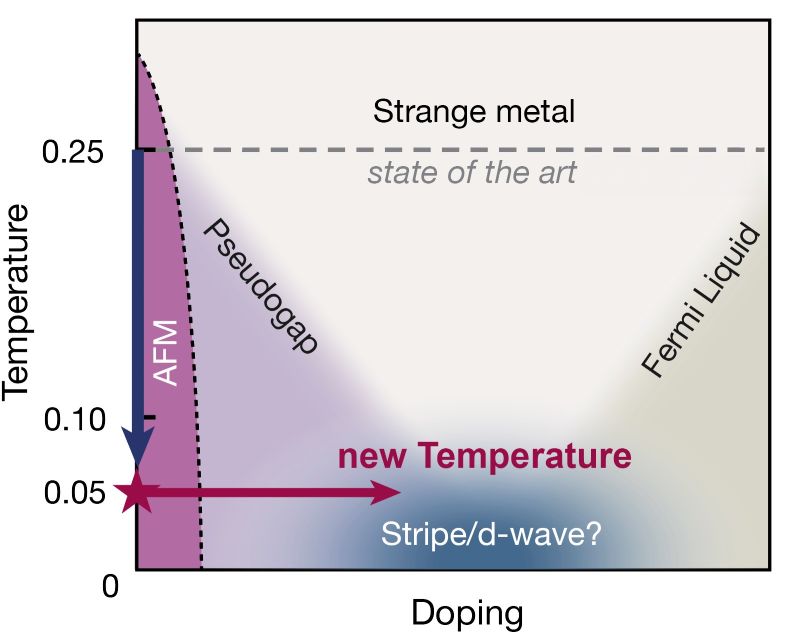 Ultracold fermionic atoms in optical lattices offer pristine realizations of Hubbard models, which are fundamental to modern condensed matter physics and the study of strongly-correlated quantum materials. Despite significant advancements, the accessible temperatures in these optical lattice material analogs are still too high to address many open problems beyond the reach of current numerical techniques. Here, we demonstrate a several-fold reduction in temperature, bringing large-scale quantum simulations of the Hubbard model into an entirely new regime. This is accomplished by transforming a low entropy product state into strongly-correlated states of interest via dynamic control of the model parameters, which is extremely challenging to simulate classically and so explored using the quantum simulator itself. At half filling, the long-range antiferromagnetic order is close to saturated, leading to a temperature of T/t=0.05 based on comparisons to numerically exact simulations. Doped away from half-filling no unbiased numerical simulation is available. Importantly, we are able to use quantum simulation to identify a new pathway for achieving similarly low temperatures with doping. This is confirmed by comparing short-range spin correlations to state-of-the-art, but approximate, constrained-path auxiliary field quantum Monte Carlo simulations. Compared to the cuprates, the reported temperatures correspond to a reduction from far above to significantly below room temperature, where physics such as the pseudogap and stripe phases may be expected. Our work opens the door to quantum simulations that solve open questions in material science, develop synergies with numerical methods and theoretical studies, and lead to discoveries of new physics.
Ultracold fermionic atoms in optical lattices offer pristine realizations of Hubbard models, which are fundamental to modern condensed matter physics and the study of strongly-correlated quantum materials. Despite significant advancements, the accessible temperatures in these optical lattice material analogs are still too high to address many open problems beyond the reach of current numerical techniques. Here, we demonstrate a several-fold reduction in temperature, bringing large-scale quantum simulations of the Hubbard model into an entirely new regime. This is accomplished by transforming a low entropy product state into strongly-correlated states of interest via dynamic control of the model parameters, which is extremely challenging to simulate classically and so explored using the quantum simulator itself. At half filling, the long-range antiferromagnetic order is close to saturated, leading to a temperature of T/t=0.05 based on comparisons to numerically exact simulations. Doped away from half-filling no unbiased numerical simulation is available. Importantly, we are able to use quantum simulation to identify a new pathway for achieving similarly low temperatures with doping. This is confirmed by comparing short-range spin correlations to state-of-the-art, but approximate, constrained-path auxiliary field quantum Monte Carlo simulations. Compared to the cuprates, the reported temperatures correspond to a reduction from far above to significantly below room temperature, where physics such as the pseudogap and stripe phases may be expected. Our work opens the door to quantum simulations that solve open questions in material science, develop synergies with numerical methods and theoretical studies, and lead to discoveries of new physics.
Ferrimagnetism of ultracold fermions in a multi-band Hubbard system
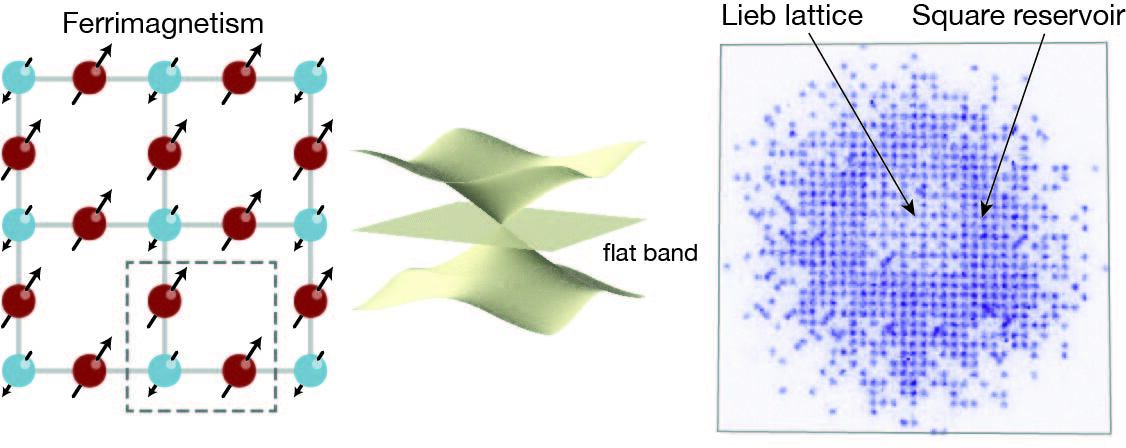 Strongly correlated materials feature multiple electronic orbitals which are crucial to accurately understand their many-body properties, from cuprate materials to twisted bilayer graphene. In such multi-band models, quantum interference can lead to dispersionless bands whose large degeneracy gives rise to itinerant magnetism even with weak interactions. Here, we report on signatures of a ferrimagnetic state realized in a Lieb lattice at half-filling, characterized by antialigned magnetic moments with antiferromagnetic correlations, concomitant with a finite spin polarization. We demonstrate their robustness when increasing repulsive interactions from the non-interacting to the Heisenberg regime, and study their emergence when continuously tuning the lattice unit cell from a square to a Lieb geometry. Our work paves the way towards exploring exotic phases in related multi-orbital models such as quantum spin liquids in kagome lattices and heavy fermion behavior in Kondo models.
Strongly correlated materials feature multiple electronic orbitals which are crucial to accurately understand their many-body properties, from cuprate materials to twisted bilayer graphene. In such multi-band models, quantum interference can lead to dispersionless bands whose large degeneracy gives rise to itinerant magnetism even with weak interactions. Here, we report on signatures of a ferrimagnetic state realized in a Lieb lattice at half-filling, characterized by antialigned magnetic moments with antiferromagnetic correlations, concomitant with a finite spin polarization. We demonstrate their robustness when increasing repulsive interactions from the non-interacting to the Heisenberg regime, and study their emergence when continuously tuning the lattice unit cell from a square to a Lieb geometry. Our work paves the way towards exploring exotic phases in related multi-orbital models such as quantum spin liquids in kagome lattices and heavy fermion behavior in Kondo models.
Observation of Nagaoka Polarons in a Fermi-Hubbard Quantum Simulator
 Quantum interference can deeply alter the nature of many-body phases of matter. In the paradigmatic case of the Hubbard model, Nagaoka famously proved that introducing a single itinerant charge can transform a paramagnetic insulator into a ferromagnet through path interference. However, a microscopic observation of such kinetic magnetism induced by individually imaged dopants has been so far elusive. Here we demonstrate the emergence of Nagaoka polarons in a Hubbard system realized with strongly interacting fermions in a triangular optical lattice. Using quantum gas microscopy, we reveal these polarons as extended ferromagnetic bubbles around particle dopants arising from the local interplay of coherent dopant motion and spin exchange. In contrast, kinetic frustration due to the triangular geometry promotes antiferromagnetic polarons around hole dopants, as proposed by Haerter and Shastry. Our work augurs the exploration of exotic quantum phases driven by charge motion in strongly correlated systems and over sizes that are challenging for numerical simulation.
Quantum interference can deeply alter the nature of many-body phases of matter. In the paradigmatic case of the Hubbard model, Nagaoka famously proved that introducing a single itinerant charge can transform a paramagnetic insulator into a ferromagnet through path interference. However, a microscopic observation of such kinetic magnetism induced by individually imaged dopants has been so far elusive. Here we demonstrate the emergence of Nagaoka polarons in a Hubbard system realized with strongly interacting fermions in a triangular optical lattice. Using quantum gas microscopy, we reveal these polarons as extended ferromagnetic bubbles around particle dopants arising from the local interplay of coherent dopant motion and spin exchange. In contrast, kinetic frustration due to the triangular geometry promotes antiferromagnetic polarons around hole dopants, as proposed by Haerter and Shastry. Our work augurs the exploration of exotic quantum phases driven by charge motion in strongly correlated systems and over sizes that are challenging for numerical simulation.
Frustration- and doping-induced magnetism in a Fermi-Hubbard simulator
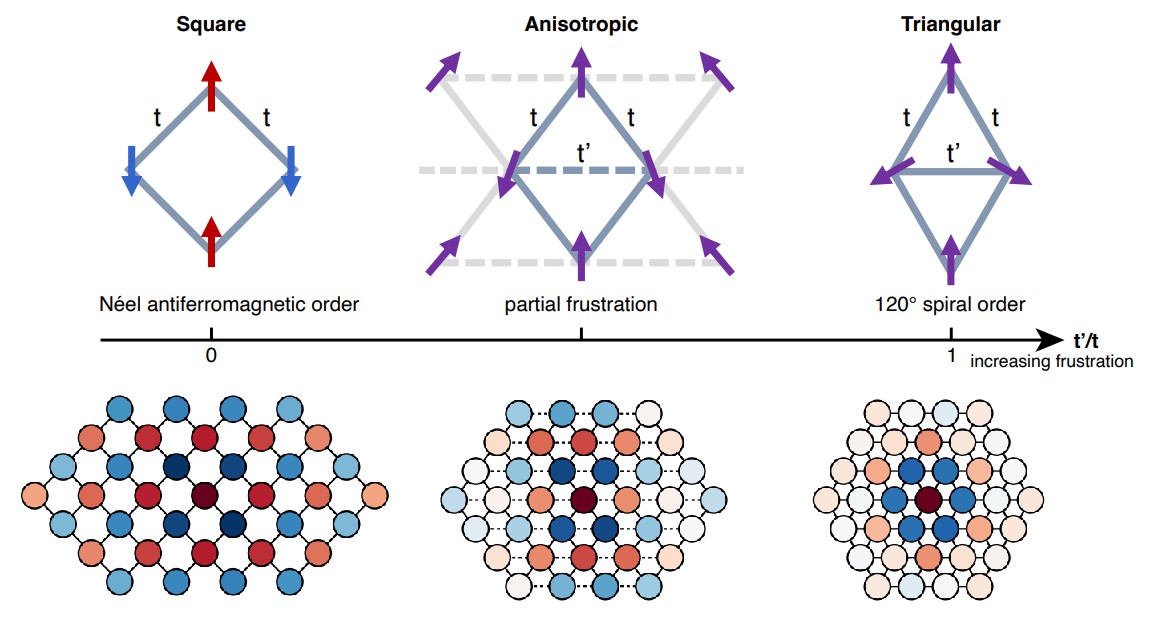 Geometrical frustration in strongly correlated systems can give rise to a plethora of novel ordered states and intriguing magnetic phases such as quantum spin liquids. Promising candidate materials for such phases can be described by the Hubbard model on an anisotropic triangular lattice, a paradigmatic model capturing the interplay between strong correlations and magnetic frustration. However, the fate of frustrated magnetism in the presence of itinerant dopants remains unclear, as well as its connection to the doped phases of the square Hubbard model. Here, we probe the local spin order of a Hubbard model with controllable frustration and doping, using ultracold fermions in anisotropic optical lattices continuously tunable from a square to a triangular geometry. At half-filling and strong interactions U/t∼9, we observe at the single-site level how frustration reduces the range of magnetic correlations and drives a transition from a collinear Néel antiferromagnet to a short-range correlated 120∘ spiral phase. Away from half-filling, magnetic correlations show a pronounced asymmetry between particle and hole doping close to triangular geometries and hint at a transition to ferromagnetic order at a particle doping above 20%. This work paves the way towards exploring possible chiral ordered or superconducting phases in triangular lattices, and realizing t-tprime square lattice Hubbard models that may be essential to describe superconductivity in cuprate materials.
Geometrical frustration in strongly correlated systems can give rise to a plethora of novel ordered states and intriguing magnetic phases such as quantum spin liquids. Promising candidate materials for such phases can be described by the Hubbard model on an anisotropic triangular lattice, a paradigmatic model capturing the interplay between strong correlations and magnetic frustration. However, the fate of frustrated magnetism in the presence of itinerant dopants remains unclear, as well as its connection to the doped phases of the square Hubbard model. Here, we probe the local spin order of a Hubbard model with controllable frustration and doping, using ultracold fermions in anisotropic optical lattices continuously tunable from a square to a triangular geometry. At half-filling and strong interactions U/t∼9, we observe at the single-site level how frustration reduces the range of magnetic correlations and drives a transition from a collinear Néel antiferromagnet to a short-range correlated 120∘ spiral phase. Away from half-filling, magnetic correlations show a pronounced asymmetry between particle and hole doping close to triangular geometries and hint at a transition to ferromagnetic order at a particle doping above 20%. This work paves the way towards exploring possible chiral ordered or superconducting phases in triangular lattices, and realizing t-tprime square lattice Hubbard models that may be essential to describe superconductivity in cuprate materials.
